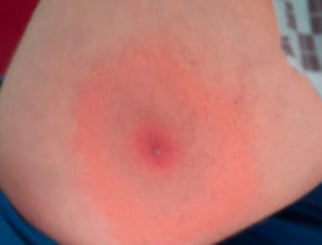About Lyme Disease
GLA Funded Research
Apply for Funding
Lyme disease occurs in three stages: early localized, early disseminated, and late disseminated. However, the stages can overlap, and not all patients go through all three. A bulls-eye rash is usually considered one of the first signs of infection, but many people develop a different kind of rash or none at all. In most cases, Lyme symptoms can start with a flu-like illness. Untreated Lyme disease symptoms can continue to worsen and turn into a long-lived debilitating illness affecting the neurological, cardiac, and immune systems of patients. Understanding the progression of Lyme disease and its potential complications is crucial in order to emphasize the importance of early detection and treatment.
Early symptoms with localized (or acute) Lyme disease may begin hours, a few days, or even weeks after a deer tick bite. At the point of initial infection, the Lyme disease bacterium has not yet spread throughout the body. Lyme is the easiest to cure at this stage with help from your health care provider, a blood test, and antibiotic treatment (available as both oral antibiotics or intravenous antibiotics).
Early Stage Symptoms may include:

Early disseminated Lyme may occur several weeks or months after the black-legged tick bite. The bacterium Borrelia burgdorferi is beginning to spread throughout the body. In addition to flu-like symptoms, this stage is often characterized by an increase in typical symptoms such as:
Many have asked, do you ever get rid of Lyme disease or other tick-borne illnesses? Do I have chronic Lyme disease? Can Lyme disease return? If Lyme disease isn’t promptly or effectively treated in the first two stages, late disseminated (post-treatment, chronic, or neurological) Lyme occurs weeks, months, or even years after the infected tick bite. The bacterial infection has spread throughout the body and nervous system, and many untreated patients develop chronic Lyme arthritis as well as an increase in neurological and cardiac symptoms. In later stages of infection, more severe Lyme disease symptoms may include:
Lyme disease presents itself in three stages, with symptoms varying in severity. However, the best approach to Lyme disease should focus on prevention rather than treatment. To minimize the risk of infection, especially in wooded areas or during outdoor activities, it is essential to prioritize protective measures. This includes wearing long-sleeved shirts and light-colored clothing and using insect repellent to deter ticks. By focusing on disease control through awareness and prevention, we can effectively reduce the chances of Lyme disease and its debilitating consequences.
Learn more
Lyme Symptom Tracker App
About Lyme Disease Testing
All About Ticks
How to Prevent Lyme Disease
Lyme disease is relentless, but so are we. Your donation powers the research that leads to breakthroughs and patient service programs that prevents suffering. Stand with us in the fight—your contribution can create lasting change and future relief for so many.
Subscribe Now to stay involved, or Donate Today to help us overcome Lyme disease.
2023 © Copyright Global Lyme Alliance. All rights reserved.
Disclaimer: The above material is provided for information purposes only. The material (a) is not nor should be considered, or used as a substitute for, medical advice, diagnosis, or treatment, nor (b) does it necessarily represent endorsement by or an official position of Global Lyme Alliance, Inc. or any of its directors, officers, advisors or volunteers. Advice on the testing, treatment or care of an individual patient should be obtained through consultation with a physician who has examined that patient or is familiar with that patient’s medical history. Global Lyme Alliance, Inc. makes no warranties of any kind regarding this Website, including as to the accuracy, completeness, currency or reliability of any information contained herein, and all such warranties are expressly disclaimed.